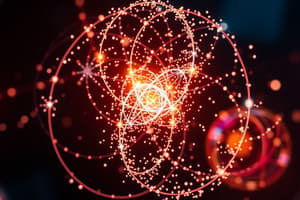Podcast
Questions and Answers
What characterizes entanglement in quantum mechanics?
What characterizes entanglement in quantum mechanics?
- Particles only share common initial states before measurement.
- Entangled particles behave exactly like classical particles.
- Particles are independent and do not influence each other. (correct)
- Particles can instantly affect each other's states, regardless of distance. (correct)
Which of the following best describes bipartite entanglement?
Which of the following best describes bipartite entanglement?
- Entangled states linking exactly two particles. (correct)
- Describes mixed entangled states across dimensions.
- Entangled states with more than two particles.
- Involves two particles that behave independently.
How does measurement affect entangled particles?
How does measurement affect entangled particles?
- It destroys the entangled state completely.
- It can create new entangled pairs.
- It has no effect on their state.
- It instantaneously determines the corresponding properties of the other particle. (correct)
Which application of entanglement enhances the sensitivity of sensors?
Which application of entanglement enhances the sensitivity of sensors?
What is a challenge related to entangled states?
What is a challenge related to entangled states?
What does Bell's theorem test in relation to entanglement?
What does Bell's theorem test in relation to entanglement?
In what way do entangled particles demonstrate non-locality?
In what way do entangled particles demonstrate non-locality?
Which statement regarding pure entanglement is accurate?
Which statement regarding pure entanglement is accurate?
What is the primary function of the axial skeleton?
What is the primary function of the axial skeleton?
Which of the following muscle pairs correctly exemplifies antagonistic action?
Which of the following muscle pairs correctly exemplifies antagonistic action?
In anatomical terms, what does 'superior' refer to?
In anatomical terms, what does 'superior' refer to?
How does understanding anatomical relationships benefit medical professionals?
How does understanding anatomical relationships benefit medical professionals?
What anatomical structures are mainly involved in complex movements of the body?
What anatomical structures are mainly involved in complex movements of the body?
What is the primary function of the musculoskeletal system?
What is the primary function of the musculoskeletal system?
Which type of muscle tissue is responsible for voluntary movements?
Which type of muscle tissue is responsible for voluntary movements?
What are tendons primarily responsible for in the musculoskeletal system?
What are tendons primarily responsible for in the musculoskeletal system?
Which type of bone is characterized by its dense and strong structure?
Which type of bone is characterized by its dense and strong structure?
What is the main role of ligaments in the body?
What is the main role of ligaments in the body?
Which type of joint allows the widest range of movement?
Which type of joint allows the widest range of movement?
Which of the following is NOT a type of muscle tissue?
Which of the following is NOT a type of muscle tissue?
What is a key characteristic of spongy bone?
What is a key characteristic of spongy bone?
Flashcards
Entanglement
Entanglement
A phenomenon in quantum mechanics where two or more particles become linked, sharing the same fate, regardless of the distance between them.
Superposition
Superposition
Quantum particles can exist in multiple states simultaneously.
Entangled States
Entangled States
Two or more quantum particles linked in a specific way, sharing the same fate.
Measurement in Entanglement
Measurement in Entanglement
Signup and view all the flashcards
Non-locality
Non-locality
Signup and view all the flashcards
Bipartite Entanglement
Bipartite Entanglement
Signup and view all the flashcards
Multipartite Entanglement
Multipartite Entanglement
Signup and view all the flashcards
Pure Entanglement
Pure Entanglement
Signup and view all the flashcards
What is the function of the axial skeleton?
What is the function of the axial skeleton?
Signup and view all the flashcards
How do muscle groups work together?
How do muscle groups work together?
Signup and view all the flashcards
What does the appendicular skeleton consist of?
What does the appendicular skeleton consist of?
Signup and view all the flashcards
Why are anatomical planes and directions important?
Why are anatomical planes and directions important?
Signup and view all the flashcards
How do the components of the musculoskeletal system work together ?
How do the components of the musculoskeletal system work together ?
Signup and view all the flashcards
What is the function of the musculoskeletal system?
What is the function of the musculoskeletal system?
Signup and view all the flashcards
What are bones?
What are bones?
Signup and view all the flashcards
What are the two main types of bone tissue?
What are the two main types of bone tissue?
Signup and view all the flashcards
What are muscles and what are their types?
What are muscles and what are their types?
Signup and view all the flashcards
What are tendons and ligaments?
What are tendons and ligaments?
Signup and view all the flashcards
What are joints?
What are joints?
Signup and view all the flashcards
What is a synovial joint and what is its purpose?
What is a synovial joint and what is its purpose?
Signup and view all the flashcards
What are fibrous and cartilaginous joints and how do they differ from synovial joints?
What are fibrous and cartilaginous joints and how do they differ from synovial joints?
Signup and view all the flashcards
Study Notes
Introduction
- Ent is likely a shorthand for the word "entanglement".
- Entanglement is a phenomenon in quantum mechanics where two or more particles become linked such that they share the same fate, regardless of the distance separating them.
- This connection allows for instantaneous correlations between the particles, seemingly violating the speed of light limit.
Key Concepts in Entanglement
- Superposition: Quantum particles can exist in multiple states simultaneously.
- Entangled states: Two or more particles are linked in a specific way, sharing the same fate.
- Measurement: Measuring a property of one entangled particle instantly determines the corresponding property of the other entangled particle, regardless of the distance.
- Non-locality: Entangled particles exhibit correlations that seem to violate locality in classical physics.
Types of Entanglement
- Bipartite entanglement: Involves two particles.
- Multipartite entanglement: Involves more than two particles.
- Pure entanglement: Entangled state is completely described by a wave function.
- Mixed entanglement: Entangled state involving statistical mixtures over various possibilities.
Applications of Entanglement
- Quantum computing: Entangled qubits can perform computations beyond the capabilities of classical computers.
- Quantum communication: Entanglement enables secure communication via quantum cryptography.
- Quantum sensing: Entanglement enhances the sensitivity of sensors.
Challenges in Entanglement
- Maintaining and controlling entangled states: Entanglement is fragile and easily disturbed by environmental factors.
- Measurement back-action: Measuring entangled states can affect their properties.
- Experimental limitations: Generating and observing entanglement over large distances remains challenging.
- Scaling up: Creating and utilizing intricate entangled systems poses significant technical hurdles.
Relation Between Entanglement and Other Concepts
- Quantum superposition: Entangled particles are in a superposition of states.
- Quantum correlations: Entanglement manifests as strong correlations between particles.
- Bell's theorem: A mathematical theorem that tests the predictions of entanglement.
- Quantum teleportation: Using entanglement to transfer quantum states from one location to another.
Human Anatomical Systems Overview
- The human body is a complex system composed of multiple interconnected systems, each with specific functions.
- These systems work together to maintain homeostasis and allow for various bodily processes.
- Anatomical structures are precisely organized to enable these functions.
Musculoskeletal System Overview
- The musculoskeletal system is composed of bones, muscles, tendons, ligaments, and joints.
- It provides support, allows movement, protects internal organs, and stores minerals.
- Skeletal muscle contractions are responsible for movement.
Bones
- Bones are rigid connective tissues that form the skeletal framework.
- They provide support, protect vital organs, and serve as levers for movement.
- Different bone types include long bones (e.g., femur), short bones (e.g., carpals), flat bones (e.g., ribs), and irregular bones (e.g., vertebrae).
- Bone structure includes compact bone (cortical bone) and spongy bone (cancellous bone).
- Compact bone is dense and strong, while spongy bone is porous and lightweight.
Muscles
- Muscles are tissues that contract to produce movement.
- There are three main types of muscle tissue: skeletal, smooth, and cardiac.
- Skeletal muscles are voluntary muscles attached to bones and are responsible for conscious movements.
- Smooth muscles are involuntary muscles found in internal organs (e.g., stomach, intestines), responsible for internal movements.
- Cardiac muscle is found in the heart, is involuntary, and responsible for pumping blood.
Tendons and Ligaments
- Tendons connect muscles to bones and transmit the force of muscle contraction to bones.
- Ligaments connect bones to bones, providing stability to joints.
- Both are composed of dense fibrous connective tissue.
- Tendons are strong and inelastic, crucial for transmitting powerful forces.
- Ligaments are more elastic, allowing for movement within a joint's range of motion.
Joints
- Joints are the points where two or more bones meet.
- They allow for movement and provide stability.
- Different types of joints include:
- Fibrous joints (e.g., sutures in the skull): allow little to no movement.
- Cartilaginous joints (e.g., intervertebral discs): allow limited movement.
- Synovial joints (e.g., knee, hip): allow a wide range of movement.
- Synovial joints are enclosed in a joint capsule and contain synovial fluid, lubricating the joint surfaces and reducing friction.
Skeletal Anatomy
- The human skeleton comprises 206 bones, divided into the axial skeleton (skull, vertebral column, ribs, and sternum) and the appendicular skeleton (limbs).
- The axial skeleton provides central support and protection for internal organs.
- The appendicular skeleton facilitates movement.
Muscular Anatomy
- Muscle groups work in antagonistic pairs to produce opposing movements.
- Muscles are categorized based on their function and location.
- Examples include the biceps brachii (flexes the forearm) and the triceps brachii (extends the forearm).
Anatomical Planes and Directions
- The body is described in terms of planes (e.g., sagittal, transverse) and directions (e.g., anterior, posterior, superior, inferior). These terms are crucial to understand anatomical locations and relationships.
- These terms are used to describe the position of structures relative to each other.
Summary of Anatomical Relationships
- The interwoven nature of bones, muscles, tendons, ligaments, and joints allows for the complex movements and functions of the human body.
- Understanding anatomical relationships enables diagnosis of injuries and guiding treatment procedures.
- The interplay of the musculoskeletal system with other body systems is critical for normal function.
Studying That Suits You
Use AI to generate personalized quizzes and flashcards to suit your learning preferences.




